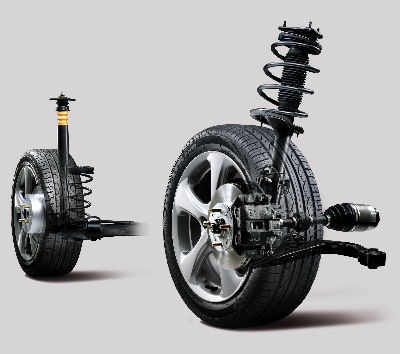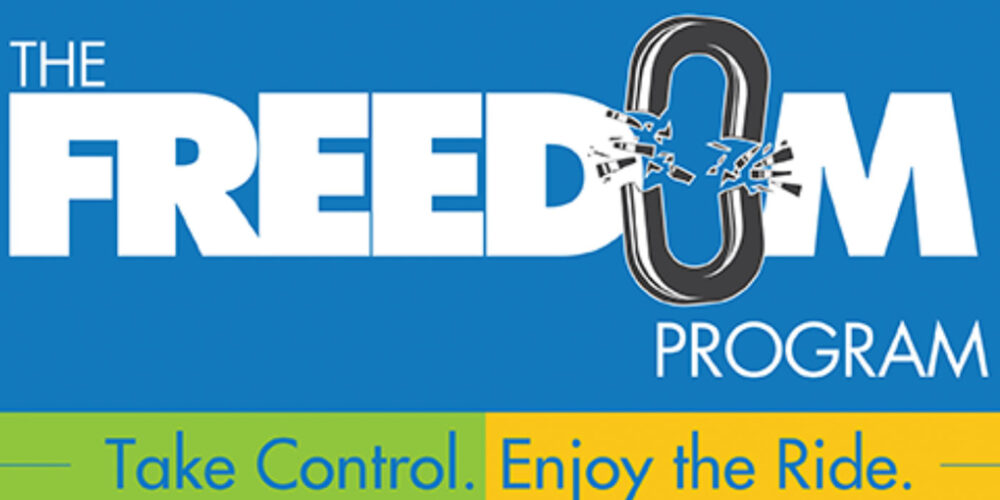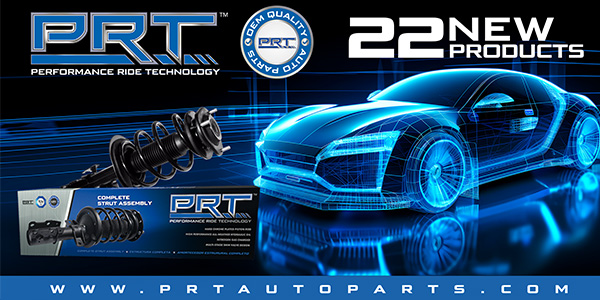Suspension noise such as clunks, squeaks or groans when passing over bumps or dips in the road can often be traced to loose ball joints, bad control arm bushings or even worn upper bearings plates on MacPherson struts.
On cars and trucks that have short long arm (SLA) suspensions, there are four ball joints: one upper and one lower on each side. The load-bearing joint (which may be the upper or lower depending on where the spring is located) is the one that experiences the most wear.
On cars with strut suspensions, there are usually no upper ball joints unless the struts are combined with a wishbone-type suspension (as in Audi and other vehicles). The weight is supported by the strut and spring. The lower ball joints are “follower” joints that carry no weight.
Worn ball joints upset camber alignment, causing a wheel to lean in. This can produce a steering pull to one side, and/or increased tread wear on the inside shoulder of the tire.
If you suspect the ball joints are worn, measure the amount of vertical and horizontal play with a dial indicator. Don’t just pry on the suspension and eyeball the play. On vehicles with SLA suspensions, the lower load-bearing joints are checked with the weight of the vehicle off the wheels while supporting the lower control arms.
On vehicles with strut suspensions, the non-load bearing lower joints are checked with the wheels off the ground and the suspension hanging free. If joint play exceeds specifications (which can vary quite a bit depending on the application), the joint is worn out and needs to be replaced.
If one ball joint is worn out, chances are the ball joint on the opposite side is also near the end of the road, even if it is still marginally within specifications. You should recommend the replacement of both joints at the same time.
DON’T OVERLOOK RIDE HEIGHT
Tire wear, steering and handling can also be affected by ride height. If the chassis is sagging on one side, or in the front or back, weak springs are the likely cause. Weak springs can affect both camber and caster, which may result in a steering pull, a change in steering effort or return and/or uneven tire wear.
Look up the ride height specifications and measure ride height front and rear, and on both sides of the vehicle. If ride height is less than specifications, the problem is most likely one or more weak springs that should be replaced. Springs can be shimmed, but the best fix is a new spring. Springs should usually be replaced in pairs to maintain the same ride height side-to-side.
Weak springs are also more likely to fail. The springs on many late-model vehicles are thinner to reduce weight, and have an outer plastic coating to protect the metal from corrosion. If this outer coating is cracked or damaged, corrosion can form a hot spot that eats into the spring, weakens it and eventually causes the spring to break.
Bushings are another chassis part that often fails with age. Most original equipment control arm bushings are made of synthetic rubber or urethane. Over time, bushings can deform, crack or lose their natural lubricity, which may cause annoying suspension squeaks and groans. Bushings are not designed to be greased, though greasing may temporarily quiet a noisy suspension. What’s needed are brand new bushings.
SHOCKS & STRUTS
Suspensions are pretty rugged and can take a lot of punishment without any ill effects — at least for a while. But tens of thousands of miles of constant pounding will eventually wear out the ride control components as well as the other suspension parts we’ve already mentioned. And the rougher the roads, the harder the pounding these parts take, and the faster they wear out.
Symptoms that would tell you the struts or shocks on a customer’s car may need to be replaced include:
• Badly cupped tires and/or noticeable tire shaking, wheel shimmy or vibration after hitting a bump.
• Suspension bottoming on rough roads or when backing out of a driveway.
• A bouncy ride.
• Body sway or rocking when cornering or driving in strong crosswinds.
• Nose dive when braking hard.
• Fluid leaking from a strut or shock.
It’s difficult to estimate how many miles a set of original equipment shocks or struts will last because damper life depends on road conditions and the type of driving your customer does. Racking up a lot of miles on smooth roads produces much less wear on the suspension and ride control components than driving on rough, potholed roads, or roads with lots of tar strips and expansion joints that produce a steady thump, thump as the wheels roll along.
Some aftermarket manufacturers say many original equipment shocks and struts are marginal after 50,000 miles of average driving. Replacing them can be recommended to restore like-new ride control and handling. But some shocks and struts may need to be replaced sooner if they have spent much of their time on rough potholed roads.
The traditional “bounce test” is still a good way to test for worn shocks and struts. Rock the suspension several times, and then release it. If the suspension continues to rock more than once or twice, the dampers are not doing their job and should be replaced.
Surprisingly, many vehicle owners never replace their shocks or struts. One survey found that 86% of the vehicles in salvage yards still have their OEM shocks or struts. The dampers were never changed because the first, second or third owner of the vehicle didn’t realize the dampers were worn out, or didn’t want to spend the money on something that didn’t seem to be absolutely necessary.
True, a worn out set of shocks or struts won’t prevent a vehicle from starting or being driven. But they can make a vehicle harder to control on a rough road, and take longer to stop on rough surfaces. So there are valid safety reasons for replacing worn shocks and struts, not just to improve ride comfort.
Though most toe alignment problems can usually be traced to worn tie rod ends, camber and/or caster misalignment may indicate a bent strut. The tubular steel construction of a MacPherson strut makes it quite stiff and strong. Even so, struts are not invulnerable to damage. A hard hit against a curb or deep pothole can sometimes bend the strut housing or shaft, causing the wheel to go out of camber and/or caster alignment.
If the damage is bad enough to alter camber and/or caster by more than half a degree, it can cause the steering to lead or pull to one side. The driver may not notice it if the lead or pull is marginal, but, over time, camber misalignment can cause uneven shoulder wear on the tire.
This type of damage is usually discovered when the vehicle is getting an alignment. If the camber, caster and/or SAI (steering axis inclination) readings are out of specifications and cannot be brought back into range using the maximum amount of adjustment that’s provided, it usually indicates bent or damaged parts such as a bent strut, bent spindle or damaged control arm bushings.
THE OVERLOOKED UPPER BEARING PLATE
Struts may also need to be replaced if the upper strut bearing plate has been hammered to death. The bearing plate serves as both the upper spring support and the steering pivot. The bearings in the plate are sealed assemblies and cannot be lubricated. So if the bearing plate is rusted, loose, worn, noisy, binding or damaged, it has to be replaced.
The symptoms of a bad bearing plate include:
• Steering noise such as snapping, popping, creaking or groaning sounds when turning.
• Suspension noise such as clunking, rattling or popping on rough roads.
• Increased steering effort (most noticeable with manual steering) brought on by binding in the bearing plate.
• Steering snap back after turning caused by a frozen upper strut bearing assembly and spring wind up.
• “Memory steer” or poor steering return where the car doesn’t want to go straight after turning due to binding in the upper mount.
One mistake to avoid when replacing struts is to reuse the original bearing plates. It’s like rebuilding an engine with a new crankshaft and reusing the old bearings. Replace the old bearing plates with new ones, or install preassembled struts that come with new bearing plates. The preassembled struts are faster and easier to install than bare struts, and they reduce the risk of comebacks.
REPLACING SHOCKS & STRUTS
As a rule, shocks and struts should always be replaced in pairs (both fronts, both rears, or all four) to maintain consistent ride control side-to-side.
Gas shocks do not need to be primed before installation, but most non-gas shocks should be primed to purge air from the piston chamber. This is done by holding the shock upright and pulling it all the way out, then turning it upside down and pushing it all the way in. Repeat this several times until the shock pumps smoothly in both directions. Never reuse old shock mounting hardware. And don’t over tighten or crush the rubber bushings. Torque all fasteners to the vehicle manufacturer’s recommendations.
If you are replacing a set of struts, don’t forget to have the wheels realigned after the installation.
Finally, don’t overlook the opportunity to offer your customer performance shocks and struts if such products would provide improved handling over the stock dampers. High-pressure, gas monotube shocks and struts are a popular upgrade and are available for most import vehicle applications. You can also get adjustable high-pressure gas shocks and struts that have variable valving, so the ride characteristics can be changed depending on the type of driving your customer is doing. Really stiff dampers are great for handling, but are not so comfortable for everyday driving on rough roads.













